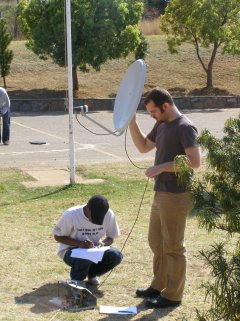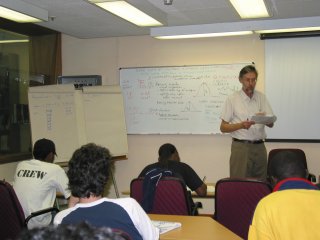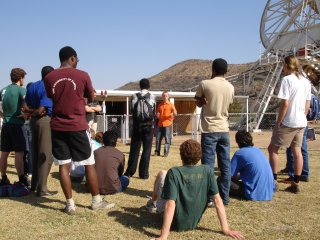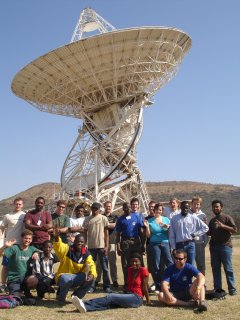
Click on image for LARGE version

They were joined by three Honours students from Rhodes University Department of Physics and Electronics - Greg Atkinson, James Barry and Steven Liddell.

Sarah Buchner was on hand to meet the students when they arrived, and started the practical the next day. The first experiment was to use a hand-held satellite dish to detect the Sun, and make an estimate of its brightness temperature.

Mike Gaylard introduced the students to the calibration of the 26-m radio telescope, using the radio sources Hydra A and Virgo A. The next day the students predicted which planets might be detectable with the radio telescope, and Jupiter was picked as a suitable target for measurements in four wavelengths bands. Drift scans were made across the planet, and these enabled its radio spectrum to be plotted and compared to that expected for a solid object of "known" temperature.

The students were introduced to the space geodesy research programme at HartRAO as well as to the radio astronomy. Here Attie Combrinck, in the orange shirt, describes the use of Global Navigation Satellite Systems for scientific purposes such measuring tectonic plate motion and the atmospheric water vapour content.

The 26-m radio telescope seen in the background spends more than 50 days each operating in global networks of radio telescopes for the purpose of studying the Earth paremeters including its rotation and orientation in space. Here Attie Combrinck describes these geodetic VLBI experiments to the students.






Sarah helped the students to spend their Saturday usefully, investigating pulsars and in turn using them to investigate the interstellar medium.
Mike returned on Sunday to introduce radio spectroscopy; the students obtained the spectrum of a radio recombination line from the well known HII region the Omega nebula. Combined with a measurement of the continuum antenna temperature via a drift scan across the nebula, they can then determine its temperature.